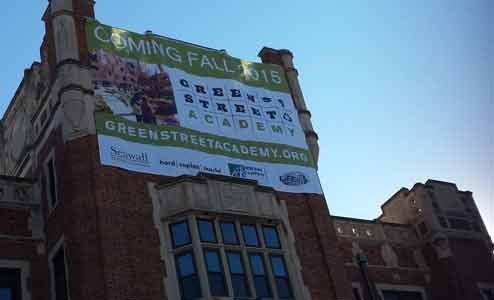BALTIMORE — The Green Street Academy building is as important to West Baltimore today, as the ground it stands on was decades ago.
The official grand opening of the six to twelfth grade charter school located in the formerly vacant Gwynns Falls Junior High School was held on Monday, September 21, 2015.
(Courtesy Photos/Green Street Academy)
Green Street Academy students show off produce made possible through the urban agriculture component of the charter school’s curriculum.
The ceremony brought out a host of students, teachers and local officials including Democratic Representative Elijah Cummings who attended the historic former Gwynns Falls Park Junior High, who delivered the keynote address.
“I can barely recognize my old junior high school,” Cummings said during the ceremony. “I am inspired by the teaching philosophy and commitment to this neighborhood exhibited by everyone at this school. I know that the dedicated staff at this school will instill every student that walks in these halls to have confidence in their competence to make their future dreams a reality.”
The building is an actualization of the vision of this school— to be a driver of environmental and more importantly economic, sustainability in the community, according to Green Street Academy’s Executive Director, Dan Schochor.
“Since 2009, the idea has been in the works and we’ve been building for two years,” Schochor said of the $23 million renovation that took place to make the opening a reality. “To get to this point makes it incredibly clear that the powerful vision of the school and getting the right people involved at the right time took the ability to maintain a certain amount of flexibility and the financial resources would not have come without all of those components.”
Schochor and others successfully combined loans and donations, including a $14 million loan from Bank of America and a $2 million loan from the Reinvestment Fund, which develops projects, to renovate the building that will eventually accommodate 875 students from grades six to 12.
The need for more STEM labs, humanities classrooms, food service and athletic space, coupled with a desire to create a signature presence in the West Baltimore area, resulted in the former Gwynns Falls Park Junior High School being chosen as the new site of Green Street Academy, school officials noted.
“The school to this point has held an incredibly important place in community,” Schochor said. “Before we moved here we were located sort of on the outskirts of where our students were coming from, not in the epicenter.
“We do know that West Baltimore needs access to high quality education. They need access to economics, healthy food and those are key components to being healthy and prepared,” he said.
Green Street Academy features a sustainability-focused curriculum that includes growing vegetables, chicken coops and tilapia farms. Advanced technology, energy, construction, agriculture, healthcare and entrepreneurship are subjects touted at the school.
The school also boasts a virtual Reality Labs that will take students through active construction sites and partnerships with the United States Department of Forestry and the University of Maryland Medical School to provide students with competitive internship experiences and industry certifications.
The Academy’s opening is a welcome break from the pattern of divestment from the once middle-class St. Joseph’s neighborhood in West Baltimore where the median income of the neighborhood is now $36,000 [annually] and nearly half of the residents don’t have high school diplomas, according to a news release.
The Academy believes that its commitment to educating not only students, but parents and residents of the community, will be a integral element in supporting an upward mobility and economic sustainability for the entire St. Joseph’s neighborhood.
“We plan to offer certification and internship programs that will give out students a leg up, preparing whether they go to college or enter a career,” Schochor said.
“Our scholars, our students, they are benefiting right now and, in the intermediate sense, it will be our families and the community who benefits,” he said. “In the long term, Baltimore and its businesses that call the city home will benefit and we will not only try to accomplish all of our ambitious goals, but we will do it 875 students at a time.”

